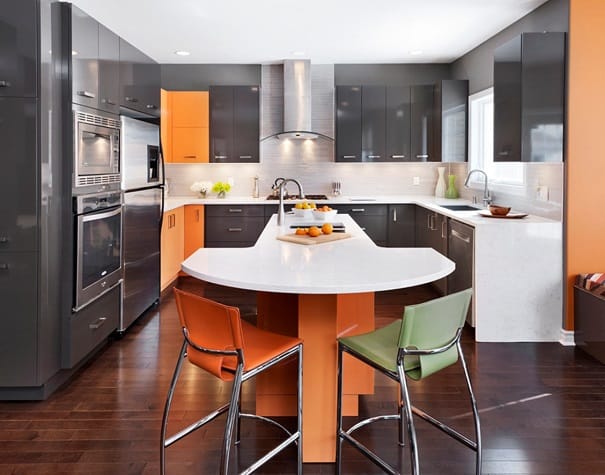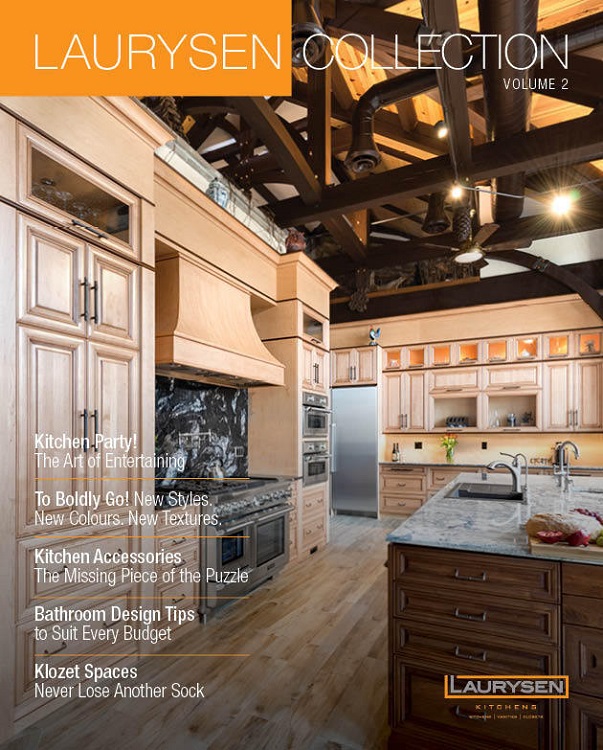“Let there be light,” goes the phrase in Genesis,  and it’s a phrase that is relevant to design of all kinds. But it’s critical in the kitchen when you’re chopping, reading labels and recipes, and plating meals.
and it’s a phrase that is relevant to design of all kinds. But it’s critical in the kitchen when you’re chopping, reading labels and recipes, and plating meals.
There is, however, a great deal of misinformation about how kitchen lighting works, and how it relates to what Laurysen does when we design for our customers.
That’s why we decided to ask our designers to tell us about kitchen lighting, to separate the truths from the fictions, and to give some tips on kitchen lighting design. Here’s the straight goods on kitchen lighting courtesy of Wael Bakr CKD (Certified Kitchen Designer), Aviva Ben-Choreen CKD, and Sara Edgerton, Design Consultant.
Three Kinds of Indoor Lighting
The first thing you need to know about kitchen lighting, our designers will tell you, is that there are actually three types with significantly different uses.
- Ambient lighting: Lighting that floods a room with a base level of light.
- Task lighting: Lighting that brightens work areas, that helps you complete kitchen tasks.
- Accent lighting: Lighting that highlights specific zones, usually for style or design flair.

“We primarily use task lighting in kitchen design,” says Aviva Ben-Choreen.
According to Ben-Choreen, task lighting is usually built from the sink outwards. Normally, a designer will identify the spots that need extra lighting, such as the countertops or island, and place task lights underneath cabinets in strategic places to shed intense light on those areas. The reason the sink is considered first is that it is the most important element of the kitchen to light: you really need to see what you’re doing in the sink.
Accent lighting, like those found inside cabinets or along the sides of counters or walls, is also implemented by designers, but it’s far less important than task lighting. Why? Because without task lighting, a kitchen is unusable.
Natural Light: The Fourth Type of Light
Natural light is always a good thing to have in a kitchen. During the day, the light coming through your kitchen window can provide a great deal of visibility (as well as adding its own special beauty). But as Wael Bakr is quick to point out, you cannot count on natural light at night.
“In northern places like Ottawa, we often cook when it is dark outside,” Bakr explains. So, it doesn’t make sense to rely on natural light, as desirable as it is. It’s also the reason that a window will never be a good substitute for a very well-placed task light.
Light, Colour and Space
In our last ask-the-designers post, many of our designers noted that use of light was very important in small kitchen design. The reason for this was simple: in general, more light will make a room feel larger, and less will make it feel smaller.
 The science behind it has its roots in the psychology of perception. Bakr explains that it has to do with the way our brain perceives colours and light. And while there is some debate about how this actually works, it seems clear that your brain is going interpret a light room differently from a dark one.
The science behind it has its roots in the psychology of perception. Bakr explains that it has to do with the way our brain perceives colours and light. And while there is some debate about how this actually works, it seems clear that your brain is going interpret a light room differently from a dark one.
Bakr explains it like this: “A darker room is going to feel cozier. A brighter room usually gives you a more open feeling.”
That means that designers need to asses the lighting feel of a given kitchen, especially if the room is unusual from a size perspective. So, if it’s a smaller kitchen, a designer may decide to put more task lighting in early on in the project.
Measuring Light
Though most designers are adept at measuring light by eye and feel alone, there are plenty of ways to ensure that the planned lighting is sufficient for the room. Sara Edgerton explains that, in addition to the sophisticated computer design programs employed by most developers, there is a whole discipline dedicated to measuring correct levels of light.
“It’s math,” says Edgerton, apologetically, “and it’s not simple math either.”
If definite accuracy is required, and fancy computer programs are not available, it’s possible to calculate the amount of light needed by using lighting tables. These tables tell you everything from the intensity of a certain kind of light to the amount of light absorbed by various colours.
Edgerton points out that much design work features this sort of dramatic intersection between precision and feeling, which is exactly the realm that lighting inhabits; it’s both a science and an an art.
The Whole Picture
Science and art—our designers live in the contrast between those two worlds. They combined a great deal of knowledge and skill to engineer a kitchen that works. And much of that “working” has to do with good use of lighting.
Lighting is an essential part of good kitchen design. Failing to consider lighting may throw off the function and beauty of the entire kitchen, and that’s something that can be easily avoided.
At the very least, we hope we’ve convinced you to take lighting into account the next time you visualize your dream kitchen. And remember, you can’t do any cooking in the dark!

